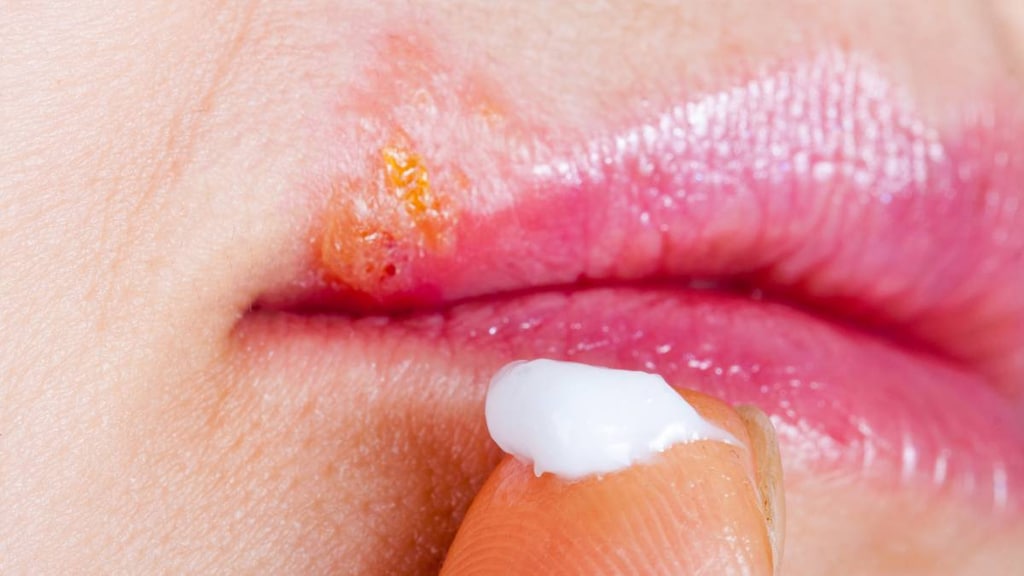Dosage Forms
Excipient information presented when available (limited, particularly for generics); consult specific product labeling.
Cream, External:
Zovirax: 5% (5 g) [contains cetostearyl alcohol, propylene glycol]
Generic: 5% (5 g)
Ointment, External:
Zovirax: 5% (30 g)
Generic: 5% (5 g, 15 g, 30 g)
Tablet, Buccal:
Sitavig: 50 mg [contains milk protein concentrate]
Pharmacology
Mechanism of Action
Acyclovir is converted to acyclovir monophosphate by virus-specific thymidine kinase then further converted to acyclovir triphosphate by other cellular enzymes. Acyclovir triphosphate inhibits DNA synthesis and viral replication by competing with deoxyguanosine triphosphate for viral DNA polymerase and being incorporated into viral DNA.
Pharmacokinetics/Pharmacodynamics
Absorption
Topical: Plasma concentrations following topical application of the cream were below the limit of detection in 5/6 male volunteers (<0.01 μM) and 0.014 μM in one subject. Following application of the ointment to patients with varicella-zoster infection, acyclovir plasma concentrations were <0.01 to 0.28 mcg/mL in patients with normal renal function and <0.01 to 0.78 mcg/mL in a patient with renal impairment.
Buccal tablet: Single dose application of buccal tablets containing 50 mg of acyclovir to the buccal mucosa provided mean maximum salivary concentrations 8 hours after tablet application. Plasma concentrations were delayed (undetectable at 5 hours) and subsequently below antiviral activity concentration (0.018 to 0.055 mcg/mL).
Excretion
Urine (Buccal tablet: Primarily renally excreted unchanged; Cream: 0.04% of the daily dose; Ointment: <0.02% to 9.4% of the daily dose)
Use: Labeled Indications
Herpes virus:
Buccal tablet: Treatment of recurrent herpes labialis (cold sores) in immunocompetent adults
Cream: Treatment of recurrent herpes labialis (cold sores) in immunocompetent children ≥12 years of age, adolescents, and adults
Ointment: Management of limited non-life-threatening mucocutaneous herpes simplex virus infections in immunocompromised patients
Contraindications
Hypersensitivity to acyclovir, valacyclovir, or any component of the formulation
Buccal tablet: Additional contraindications: Hypersensitivity to milk protein concentrate
Dosage and Administration
Dosing: Adult
Herpes labialis (cold sores), recurrent:
Topical cream: Apply 5 times daily for 4 days
Buccal tablet: Apply one 50 mg tablet as a single dose to the upper gum region (canine fossa)
HSV, mucocutaneous (non-life-threatening, immunocompromised): Topical ointment: 1/2” ribbon of ointment for a 4” square surface area every 3 hours (6 times daily) for 7 days
Dosing: Geriatric
Refer to adult dosing.
Dosing: Pediatric
Herpes labialis (cold sores): Topical cream: Children ≥12 years and Adolescents: Apply 5 times/day for 4 days
Administration
Oral: Buccal tablet: Apply within 1 hour after onset of prodromal symptoms and before appearance of any signs of lesions. Apply tablet with a dry finger immediately after removing it from packaging blister. Place tablets to the upper gum just above the incisor tooth (canine fossa) on the same side of the mouth as the prodromal symptoms and hold in place with slight pressure over the upper lip for 30 seconds to ensure adhesion. The rounded side of the tablet should be placed on the upper gum (for comfort purposes, does not affect efficacy). Do not crush, chew, suck, or swallow. If tablet falls off within the first 6 hours, reposition the same tablet immediately or apply a new tablet. If tablet is swallowed within the first 6 hours, drink a glass of water and apply a new tablet. If tablet falls out or is swallowed after the first 6 hours, do not reapply. Patients may eat and drink normally while tablet is in place. Avoid gum chewing, brushing teeth, wearing an upper denture or touching/pressing the tablet after placement. Rinse mouth gently if teeth need to be cleaned while the tablet is in place. Drink plenty of liquids in case of dry mouth.
Topical: Cream or ointment: Apply as early as possible following the onset of prodromal symptoms or when lesions appear.
Cream: Not for use on the genitals. Ensure the face and/or lips are clean and dry. Not for use in the eye, mouth or mucous membranes. Wash hands with soap and water prior to application and after application. Apply sufficient amount to adequately cover all lesions, including the outer margin. Avoid unnecessary rubbing of the affected area. Do not apply other topical products to the affected area during therapy.
Ointment: Not for use in the eye. Apply sufficient amount to adequately cover all lesions. Apply using a finger cot or rubber glove to avoid transmission to other parts of the body or to other persons.
Storage
Buccal tablet: Store at 20°C to 25°C (68°F to 77°F); excursions permitted between 15°C and 30°C (59°F and 86°F). Protect from moisture.
Cream: Store at or below 25°C (77°F); excursions permitted between 15°C and 30°C (59°F and 86°F).
Ointment: Store at controlled room temperature of 20°C to 25°C (68°F to 77°F) in a dry place.
Drug Interactions
Talimogene Laherparepvec: Antiherpetic Antivirals may diminish the therapeutic effect of Talimogene Laherparepvec. Monitor therapy
Adverse Reactions
>10%: Dermatologic: Local pain (ointment 30%; mild; includes transient burning and stinging)
1% to 10%:
Central nervous system: Lethargy (buccal tablet 1%)
Dermatologic: Erythema (buccal tablet 1%), skin rash (buccal tablet 1%)
Gastrointestinal: Aphthous stomatitis (buccal tablet 1%), gingival pain (buccal tablet 1%)
Local: Application site reaction (cream 5%; including dry lips, desquamation, dryness of skin, cracked lips, burning skin, pruritus, flakiness of skin, and stinging on skin); application site irritation (buccal tablet 1%)
<1%, postmarketing, and/or case reports: Anaphylaxis, angioedema, contact dermatitis, eczema, localized edema, local pruritus, pruritus
Warnings/Precautions
Concerns related to adverse effects:
- Dermatologic toxicity: Cream may be irritating and cause contact sensitization. The sensitizing ingredient has not been identified.
Disease-related concerns:
- Appropriate use: Genital herpes: Physical contact should be avoided when lesions are present; transmission may also occur in the absence of symptoms. Treatment should begin with the first signs or symptoms. There are no data to support the use of acyclovir ointment to prevent transmission of infection to other persons or prevent recurrent infections if no signs or symptoms are present.
- Appropriate use: Herpes labialis: Treatment should begin with the first signs or symptoms.
Special populations:
- Immunocompromised patients: Buccal tablet, cream: Use and safety has not been studied; use with caution.
Dosage form specific issues:
- Buccal tablet: Apply to the area of the upper gum above the incisor tooth on the same side as the symptoms; do not apply to the inside of the lip or cheek.
- Cream: For external use only to the lips and face; do not apply to eye or inside the mouth or nose, or to any mucous membranes.
- Ingredient precaution: Some products may contain milk protein concentrate.
- Ointment: For cutaneous use only; do not use in the eye.
Pregnancy
Pregnancy Considerations
When administered orally, acyclovir crosses the placenta. The amount of acyclovir available systemically following topical application of the cream, buccal tablet, or ointment is significantly less in comparison to oral doses.
Refer to the Acyclovir (Systemic) monograph for details.
Patient Education
What is this drug used for?
- It is used to treat cold sores.
- It is used to treat genital warts.
- It is used to treat herpes infections.
Frequently reported side effects of this drug
- Burning
- Stinging
- Dry skin
- Itching
- Dry lips
- Application site pain
- Headache
Other side effects of this drug: Talk with your doctor right away if you have any of these signs of:
- Severe application site irritation
- Signs of a significant reaction like wheezing; chest tightness; fever; itching; bad cough; blue skin color; seizures; or swelling of face, lips, tongue, or throat.
Note: This is not a comprehensive list of all side effects. Talk to your doctor if you have questions.
Consumer Information Use and Disclaimer: This information should not be used to decide whether or not to take this medicine or any other medicine. Only the healthcare provider has the knowledge and training to decide which medicines are right for a specific patient. This information does not endorse any medicine as safe, effective, or approved for treating any patient or health condition. This is only a brief summary of general information about this medicine. It does NOT include all information about the possible uses, directions, warnings, precautions, interactions, adverse effects, or risks that may apply to this medicine. This information is not specific medical advice and does not replace information you receive from the healthcare provider. You must talk with the healthcare provider for complete information about the risks and benefits of using this medicine.

